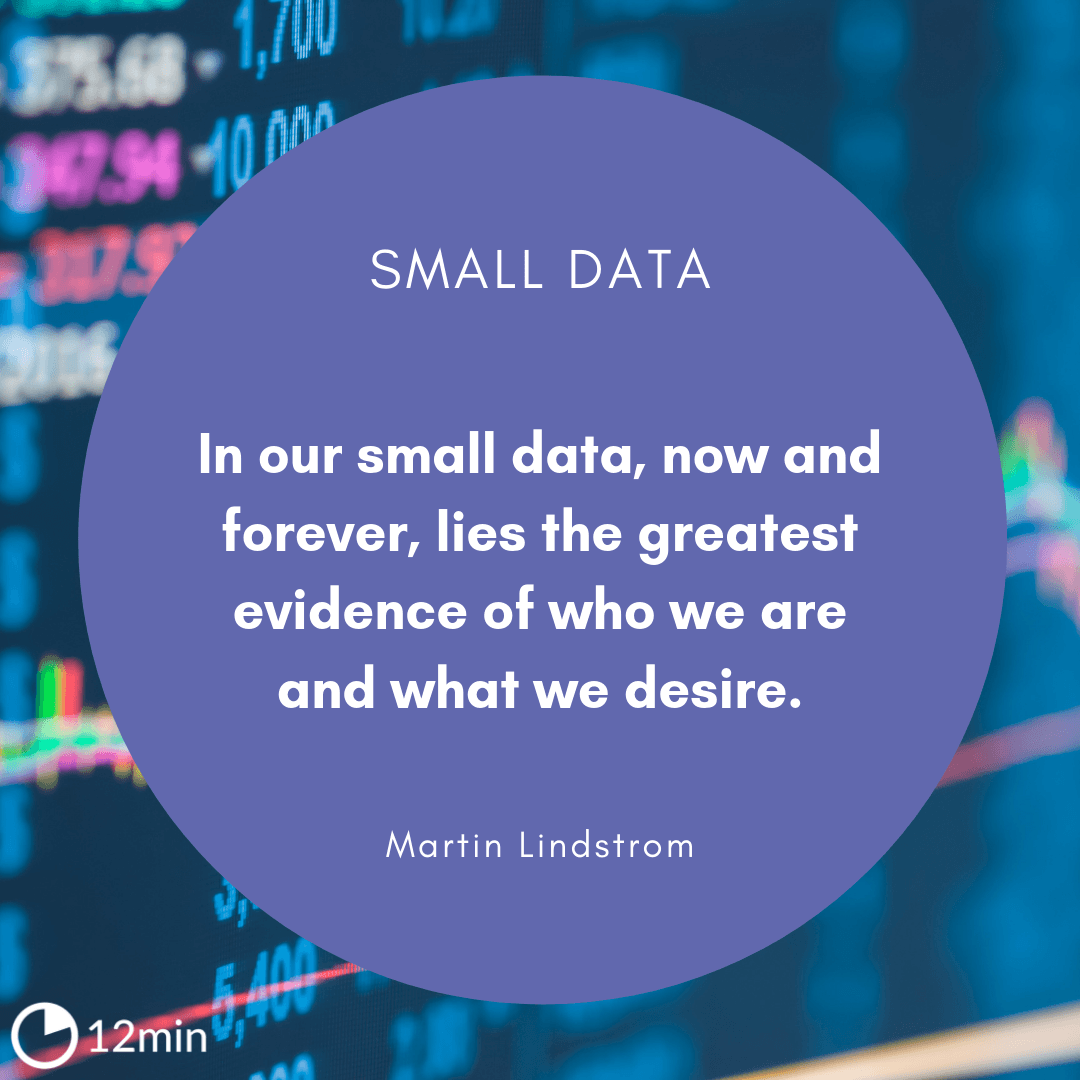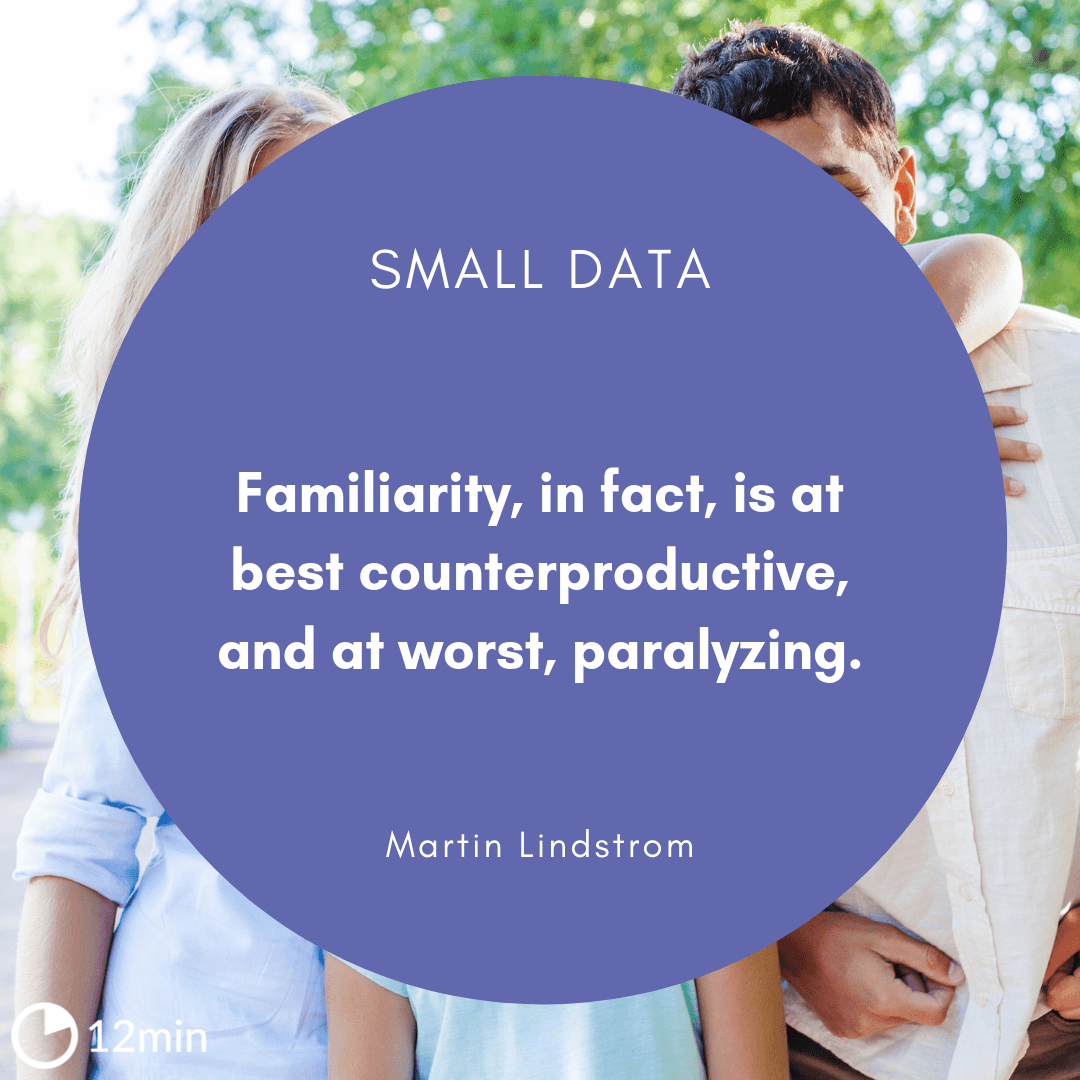Small Data Summary

6 min read ⌚
In a business world where big data basks in the spotlight, give yourself the opportunity to venture backstage. Big data can show the general tendencies of a product, company, or industry. The quest of discovering the extraordinary – that great shift in dynamics in your designated market – begins from the main pointers that big data offers. In Small Data, Martin Lindstrom explains why you shouldn’t ignore small data, and the valuable lessons it can teach you.
A brand’s soul comes down to its humanity – creating a bond that resonates with a substantial number of individuals.
At the end of the day,
“If companies want to understand consumers, big data offers a valuable, but incomplete, solution.”
BRANDING / SMALL DATA
“A great brand promises hope, the contagion of coolness, or desirability, or love, or romance, or acceptance.”
The overall information big data offers just scratches the surface. It’s time to dig for small data. It’s imperative for you to actively participate in this part, out in the field, gathering observations in person. Remember that a successful brand is something that meets customers’ desires.
Honestly, small data is very much trial-and-error as some strategies won’t work out; those that do usually need to be greenlit by company executives. Still, every scrap of small data you collect can be valuable in the future.
The idea of Small Data: The Tiny Clues That Uncover Huge Trends was born in Zambia. In it, Martin Lindstrom explores the psychological and compartmental behavior of humans. His core observation is that individuals from different cultures may see the world differently, but are actually quite similar.
Martin Lindstrom is a consumer branding expert, best-selling author, keynote speaker, and one ofTIME magazine’s “World’s 100 Most Influential People”. Born and raised in Skive, Denmark, he’s an extraordinary observer who never had any formal training. His deductive skills and his unique understanding of the human nature have transformed Lindstrom into a one-of-a-kind branding consultant.
We learn the techniques of collecting and processing small data, discovering what occurs when one note taken today links with another gathered months or years ago. In a world were big numbers often lead to an incomplete branding strategy, small data offers to add the magic ingredient. It takes time, but the results results speak for themselves.
Small Data is split into 8 chapters. The first 7 contain pieces of small data that, linked together, form the foundations of various branding strategies. The clues are stretched throughout the book, showing that the development of a hypothesis is non-linear – bits of small data can be reused later, in a completely different case.
Want to know how sausages and chicken forever transformed the way we shop for food? Small Data explains that. Chapter 4 has insights from the fast food world, a Middle Eastern movie theater, and a hotel lap pool in. Next you’ll find out how horses, short collars, and religious belief played a role in saving a struggling Brazilian beer brand.
Going into chapter 7, uncover the meaning of “quality” in China by observing charred paper, toy cars, and pixie dust. The last section of the book shows you how to incorporate small data into your business and life, by offering a glimpse behind the scenes.

The key concepts from Small Data are:
- Subtext research, or Subtexting, helps to recognize small data, which in the end leads to the birth of the concept. It’s a time-consuming process, which can take weeks or even months.
- Small data represents a mixture of “gestures, habits, likes, dislikes, hesitations, speech patterns, decors, passwords, tweets, status updates and more.” Nothing is off-limits. The selection is made from the Subtexting, carefully choosing the collage upon which a hypothesis is built.
- Small mining. This is where that mosaic takes shape, where a plausible story line is constructed. Uncovering the desire that needs to be met by a brand. It’s seldom a straightforward process, being more of an experimental approach. It’s ongoing, constantly changing shape and form, until the right pieces fall into place.
Moreover, here are 5 actionable things from Martin Lindstrom’s book to use on the path of creating a branding strategy:
- Building trust. By conducting field interviews, you’re in unknown territory. You need to do your homework. Find out major points of interest and become an expert on them. This is how you establish a connection – having several icebreakers up your sleeve. Bonding over shared subjects is the ideal way of ensuring that your respondents will be at ease in your presence. With their walls down, you’ll be able to observe them better.
- “Change the script.” Through experimentation, Lindstrom discovered that by placing a brand or an object in the room where people are interviewed, a shift in conversation occurred in 75% of the cases, with an average of 7 minutes spent on discussing said object or brand. So, if you want to steer the conversation your way, this technique might prove successful.
- Determine a consumer’s Twin Self. In the communication column on your brand’s blueprint, this needs to be written in bold: “communicate, always, to a consumer’s Twin Self.” You want to build a lasting two-way dialogue between brand and customer. “Twin Self” refers to the inner age of a person, and it’s “directly connected to the first time we felt liberated and on our own.” It’s a turning point, like buying a car, leasing an apartment, and so on.
- Make sure executives use their own product(s). Some of the higher-ups from various companies have lost touch with their products. To remedy this situation, get them to experience said goods in the same way customers do. Identifying the shortcomings by themselves will make the executives more agreeable to change, and they may even play a role in the process.
- Be an outsider. Distance yourself from your cultural customs and personal preferences. For example, if you’re conducting research for a product to which you are accustomed, it’s required to remove it from your routine. When looking for things out of the ordinary, you can miss some things if you’re too close.
Onwards, it’s a sneak peek from the last chapter – the theory on which all the case studies from Small Data are based, which can be used in the field of branding strategy. Lindstrom calls them the 7Cs:
- Collecting. Define a baseline view of the culture that you’ll analyze by talking to expats, and local observers such as bartenders and hairdressers, the people who interact with others as part of their role in the community. As you acquire these initial insights and hypotheses, you’ll also have some conversation starters for when you enter someone’s home.
- Clues. Once you’re in the respondents’ living space search for things that don’t seem right, which don’t tell a coherent story. Nothing is unimportant: take notes, photos, and videos. Look through the pictures and antiques from the living room. These items construct a past, giving you a helpful perspective on who that person is and where they’ve been. Paying close attention to refrigerators, kitchen cabinets, wardrobes, garages, and online folders can reveal the interior conflict of a person.
- Connecting. At this stage you’ll have a couple of pieces of small data at your disposal. Now find a response to each of these questions: “Are there any similarities among the clues you have accumulated? Are the clues beginning to tilt in one direction? If you had one, are you beginning to validate your initial hypothesis?” Remember that you’re searching for an emotional rift – “too much or too little of something”. If the body language of your respondents shows irritation or nervousness, you’re on the right path.
- Causation. By moving to your office with the conclusions drawn from the previous stages, you start the process of Small Mining. Stick your photos and notes up on the wall. Pinpoint the connection between different observations. Find the answer to “What emotion will this evoke in a human being?” It’s crucial to put yourself in the place of the people you interviewed.
- Correlation. Pick up on a change in behavior, your the entry point: any sizable twist in your respondents’ personal life or careers. To help you through this step, reach out to the friends and family of the individual to confirm or contradict your findings. You also need to reset your view, keeping in mind that familiarity clouds judgment.
- Compensation. After you got the confirmation of a change, you’re now ready to uncover its most emotional aspect – desire. Ask yourself, “What is the desire that is not being fulfilled? What is the best way to fulfill it?”
- Concept. Ponder over all your observations in a quiet place, preferably at home. Don’t try to stare them down. Just let your mind roam free, and the next big idea will appear. Pressure is not a friend in this undertaking. Time is.

To wrap up our journey into Small Data, I’ll say that this volume fascinated me from the introduction. There, Martin Lindstrom mentions his passion for Lego, which I share, and shows why his resilient nature manifested from such a young age – he turned idle hours during a long stay in hospital (due to a childhood illness) into a useful pastime: collecting clues and developing his awareness.
I hope your curiosity is flourishing, and that you’ll dive in for more in Small Data: The Tiny Clues That Uncover Huge Trends.
Like this summary? We’d like to invite you to download our free 12 min app for more amazing summaries and audiobooks.








